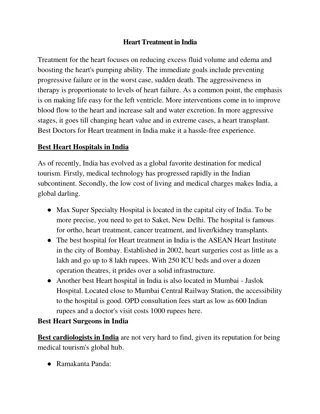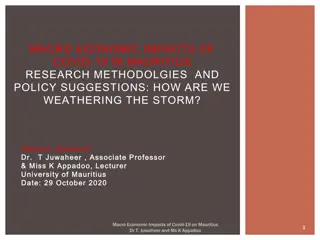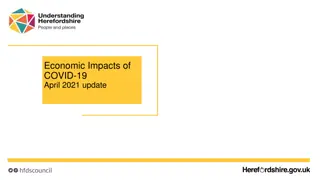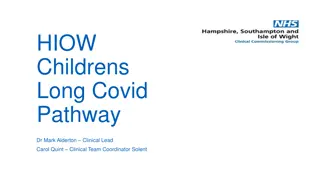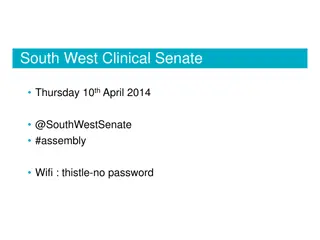Economic Impacts of COVID-19 on Heart of the South West LEP Area
The economic impacts of COVID-19 on the Heart of the South West LEP area are detailed in a report by Gabrielle Climie from Marchmont Observatory. The report covers national context, local impact, sectoral impact, local strategy projections, productivity impact, and more, highlighting challenges faced by businesses such as deferring VAT payments, decreased turnover, and workforce furlough leave. Insights from ONS data reveal trends in GDP, hours worked, retail sales, and business operations, emphasizing the ongoing struggle and adaptations in various industries.
Download Presentation

Please find below an Image/Link to download the presentation.
The content on the website is provided AS IS for your information and personal use only. It may not be sold, licensed, or shared on other websites without obtaining consent from the author.If you encounter any issues during the download, it is possible that the publisher has removed the file from their server.
You are allowed to download the files provided on this website for personal or commercial use, subject to the condition that they are used lawfully. All files are the property of their respective owners.
The content on the website is provided AS IS for your information and personal use only. It may not be sold, licensed, or shared on other websites without obtaining consent from the author.
E N D
Presentation Transcript
Heart of the South West LEP Skills Advisory Panel Economic Impacts of COVID-19 on the Heart of the South West LEP Area Gabrielle Climie Marchmont Observatory September 2020
Contents National Context Local Impact Sectoral Impact Local Strategy Projections
National Overview Nearly half of businesses that had not permanently ceased trading were deferring VAT payments. 46% of businesses that had continued to trade reported that turnover had decreased below what is average for this time of year between 24th August and 6th September. Job adverts between 4 and 11 September, increased from 50% to 53% of their 2019 average according to Adzuna data. 10% of the workforce remained on furlough leave, and 11% of businesses were at a moderate or severe risk of insolvency.
ONS Roundup Monthly gross domestic product (GDP) grew by 6.6% in July 2020 but is 11.7% lower than the February 2020 level. Total hours worked was still low but showed some signs of recovery in the three months to July 2020. Over the year, average actual weekly hours fell by 5.8 hours to 26.3 hours in the three months to July 2020 . The volume of retail sales increased by 3.6% in July 2020 compared with the previous month and is now 3.0% above pre-pandemic levels. The proportion of adults travelling to work rose above 60% for the first time since the introduction of the OPN survey.
ONS BICS Impact In the 10th September release of ONS data on business impact, across all industries 6% of the workforce that were still on partial or furlough leave returned from leave in the last two weeks . Of all businesses responding, 15% reported that operating costs exceeded turnover, 12% reported that operating costs were equal to turnover, and 49% reported that turnover exceeded operating costs. Of businesses not permanently stopped trading, 36% of the workforce were working remotely instead of at their normal place of work.
Productivity Impact In the first quarter of 2020 (January to March), output per hour fell by 0.6% compared to this quarter in the previous year. Output per worker has fallen considerably, in part due to furlough sustaining the number of workers but reducing hours worked. The main driver of the fall in output per hour is Non- financial services, while Construction and Allocation grew. Productivity updates are due on the 7th October.
Productivity Impact Quarter on same Quarter on previous Series Labour productivity Output per hour Status quarter a year ago quarter National Statistic National Statistic National Statistic Experimental Statistic Experimental -0.6% -1.3% Output per worker -3.1% -2.8% Output per job -3.3% -3.0% Multi-factor productivity Public service productivity (quarterly estimate) Unit labour costs -2.6% -2.2% -4.8% -4.1% Statistic National Statistic 6.2% 3.3% Source: ONS Productivity economic commentary: January to March 2020
ONS Sectoral Impact - Trading Source: ONS - Coronavirus and the economic impacts on the UK: 10th September 2020
ONS Sectoral Impact - Turnover Source: ONS - Coronavirus and the economic impacts on the UK: 10th September 2020
Business Impact Survey Business West Chambers of Commerce completed a survey of 1139 businesses between 2nd and 17th April 2020. The overwhelming majority of respondents (96%) said that the coronavirus was impacting their business. While 5% said they had seen increased sales, 72% said sales had decreased and 56% had lost business through cancelled contracts or orders. 50% reported cash flow problems, and 30% reported supply chain issues. 88% of businesses expressed concern about their future financial position.
Use of Furlough County and district / unitary authority Employments furloughed Take-up rate Plymouth UA 36,400 31% Torbay UA 20,000 37% East Devon 19,700 34% Exeter 17,400 30% Mid Devon 10,900 30% North Devon 14,400 36% South Hams 11,700 35% Teignbridge 19,900 35% Torridge 9,200 36% West Devon 6,700 32% Mendip 17,800 35% Sedgemoor 16,700 30% Somerset West and Taunton 20,900 31% South Somerset 22,900 31% Heart of the South West 244,600 33% UK 9,601,700 32% Source: ONS Coronavirus Job Retention Scheme statistics August 2020 use of the scheme up to the 31st July
Use of SEISS County and district / unitary authority Total no. of claims made Total value of claims made ( 000) Take-Up Rate Plymouth UA 8,700 24,100 79% Torbay UA 6,200 17,600 78% East Devon 6,900 20,600 74% Exeter 4,200 12,700 77% Mid Devon 4,300 13,000 71% North Devon 5,600 15,900 76% South Hams 5,400 15,400 75% Teignbridge 6,500 18,700 76% Torridge 4,200 11,600 74% West Devon 3,200 9,000 72% Mendip 6,000 17,600 72% Sedgemoor 5,200 16,300 75% Somerset West and Taunton 6,700 19,600 74% South Somerset 7,100 20,700 72% Heart of the South West 80,200 232,800 75% United Kingdom 2,604,000 7,576,000 77% Source: ONS Self-Employment Income Support Scheme statistics August 2020 use of the scheme up to 31st July
Support Summary Torbay stands out in the LEP area for its 37% furlough rate, as well as the 78% take up of the SEISS, just below Plymouth s 79%. The next highest level of SEISS use is in Exeter, which has possible implications for the city as a centre of employment: it is, however, the same rate as the UK overall. Furlough rates across the South West and Heart of the South West are largely higher than average for England. Furlough use is particularly low in Exeter, Mid Devon and Sedgemoor.
Claimant Count Breakdown March 2020 Rate June 2020 Rate August 2020 Rate Total Claimants in August 2020 New since March Area % Change United Kingdom 3.0 6.2 6.5 2,726,510 1,457,890 115% South West 2.2 5.1 5.4 183,350 107,660 142% Heart of the South West 2.4 5.2 5.5 57,005 32,580 133% Devon 1.8 4.6 4.9 22,730 14,140 165% Plymouth 3.5 6.3 6.6 11,020 5,230 90% Somerset 2.3 4.9 5.3 17,180 9,810 133% Torbay 3.5 7.6 7.9 6,080 3,405 127% Source: ONS claimant count by sex and age - not seasonally adjusted - NOMIS
Claimant Count by LA Total Claimants in August 2020 3,620 3,900 3,895 2,070 3,270 11,020 4,130 4,480 Local authority: district / unitary New since March March 2020 Rate June 2020 Rate August 2020 Rate % Change East Devon Exeter Mendip Mid Devon North Devon Plymouth Sedgemoor Somerset West and Taunton South Hams South Somerset Teignbridge Torbay Torridge West Devon 1.8 1.7 2.3 1.7 2.2 3.5 2.8 2.2 4.4 4.0 5.3 4.0 5.7 6.3 5.4 4.6 4.6 4.3 5.8 4.3 5.9 6.6 5.8 5.1 2,240 2,345 2,315 1,250 2,040 5,230 2,115 162% 151% 147% 152% 166% 90% 105% 2,570 1,680 2,805 2,415 3,405 1,265 915 135% 227% 150% 165% 127% 141% 187% 1.5 1.9 1.9 3.5 2.3 1.6 4.8 4.6 4.9 7.6 5.4 4.0 5.0 4.9 5.1 7.9 5.6 4.5 2,420 4,670 3,880 6,080 2,165 1,405
Claimant Count by Age - HotSW New since March Age March 2020 June 2020 August 2020 % Change 24,425 53,690 57,005 All categories 32,580 133% 105 180 160 Aged 16-17 55 52% 4,770 11,080 11,385 Aged 18-24 6,615 139% 13,410 28,920 31,005 Aged 25-49 17,595 131% 6,135 13,505 14,455 Aged 50+ 8,320 136% Source: ONS claimant count by sex and age - not seasonally adjusted
Claimant Summary Claimant count has increased significantly across the LEP area since March. Plymouth and Torbay are notable for having claimant count rates higher than the national average. The only lower tier local authority not to more than double their claimant count is Plymouth. South Hams had the largest proportional increase. The Claimant Count has increased fastest in terms of percentage in the LEP area for the 18-24 age group. It is worth noting that due to the circumstances of the pandemic, the figures for universal credit claims may have been affected by changes in the eligibility criteria for otherwise employed people.
CPP - LA Impact Analysis by the Centre for Progressive Policy based on OBR data suggests that the impact of coronavirus will be wildly different on a regional basis. The OBR expects an average 35% drop in GDP in the second quarter of this year, with no local authorities in the LEP area in either the top or lowest 10. 10 of the local authorities in the LEP area are predicted to have a larger than average GVA drop: Sedgemoor is predicted the largest (41%) and Somerset West and Taunton the lowest (30%).
RSA - LA Impact RSA Analysis suggests that up to 35% of jobs in parts of Britain are at risk. West Devon is within the top 10 local authorities for percentage of jobs most at risk, with East Devon, Torbay and Torridge also within the top 20. Only Exeter is within the top 20 local authorities least at risk, but still has 23% of jobs rated as high-risk . However, for just England and Wales this increases to 7 of the 25 highest risk local authorities being in the Heart of the South West LEP area.
City and Town Impact According to the Centre for Cities, Exeter is ranked 61st of 63 for claimant count rate, one of the lowest in the country. No cities in the Heart of the South West are in the top 10. Plymouth, however, is among the top cities in the country for vulnerability to export impact, with over half of Plymouth s exporting jobs exposed (on top of the impact to local services). The Centre for Towns notes that 28% of the most deprived towns before the pandemic were coastal towns, an area of particular impact for the LEP. This corresponds to worries about particular towns such as Exmouth with large percentages of employment in accommodation. This report also notes the vulnerability of Torbay due to having one the highest old age dependency ratios in the country.
Sectoral Profile Sector A:agriculture and fishing HotSW South West England UK 2.8% 1.6% 0.9% 1% B,D,E:energy and water 2.0% 1.7% 1.5% 1.7% C:manufacturing 9.7% 9.1% 9.0% 8.9% F:construction 7.0% 7.2% 7.0% 7.1% G,I:distribution, hotels and restaurants 21.7% 19.0% 17.7% 17.8% H,J:transport and communications 5.8% 7.0% 9.5% 9.1% K-N:banking, finance and insurance 14.0% 16.6% 18.3% 17.7% O-Q:public admin. education and health 31.7% 31.9% 29.9% 30.3% R-U:other services 5.0% 5.6% 5.8% 5.8% Source: NOMIS Annual Population Survey April 2019-March 2020 - % of all employment by sector (SIC 2007)
Sectoral Impact The Heart of the South West LEP area has higher than national average proportions of employment in the heavily affected Accommodation and Food Service, and Education sectors. However, it also has less than average employment in sectors such as banking, finance and insurance, a high GVA sector with greater capacity for working from home.
OBR Sectoral Impact The Office for Budget Responsibility set out a reference scenario for the impact of the coronavirus on different sectors GVA that shows their weighting in the economy. This is pictured on the following slide. While the reference scenario is designed for the UK, it can be used to analyse locally with re-weighting.
OBR Sectoral Impact Source: Centre for Progressive Policy Which local authorities face the biggest immediate economic hit?
OBR Sectoral Impact By re-weighting the GVA proportions in the economy based on the most recent data, individual area impacts can be seen: the LEP data is not as up to date, but information is available at the local authority level. Over the LEP area, sectors of particularly high impact compared to the UK overall are Devon Agriculture, Public administration and defence, and Accommodation and food services Plymouth Public administration and defence, Manufacturing, and Human health and social activities Somerset Agriculture, Mining, energy and water supply, and Manufacturing Torbay Accommodation and food services, Human health and social activities, and Education
Roadmap to Recovery The Roadmap to Recovery published by the LEP highlights the likely heavy impact on rural and coastal areas. Despite a relatively low caseload, the LEP area is also at particular risk due to its sectoral profile. The current priorities as the lockdown eases are to Restart, Revitalise and Grow the economy in partnership with government. Key responses will include investment in the hardest hit areas and sectors, skill development, and drawing on existing LEP commitments to clean, inclusive and emerging technology focused growth.
HotSW Growth Hub The Heart of the South West Growth Hub provides links to the current government guidance to help businesses keep up to date. It also provides the current version of the Better Business For All Toolkit, including risk assessment and action plan templates. The Growth Hub encourages the use of the government Skills Toolkit for online upskilling. This service has advisers available for any unresolved queries from the online resources. The Hub should help businesses survive and adapt.
CPP Future Projections According to the Centre for Progressive Policy s Back from the Brink report, 76% of local authorities will not have recovered their expected output level based on pre-crisis figures after five years. Wage stagnation is expected to continue, with regional inequality increasing and poorest households being hit hardest. However, all local authorities in the Heart of the South West are rated in the Moderate or Resilient recovery categories, with East Devon, Torridge and West Devon considered Resilient none are rated as Vulnerable. With this in mind, it is important to note that the report states that this addresses immediate impact that the places that are hit most heavily by initial impact are not necessarily the same as places that will struggle in the long term.




